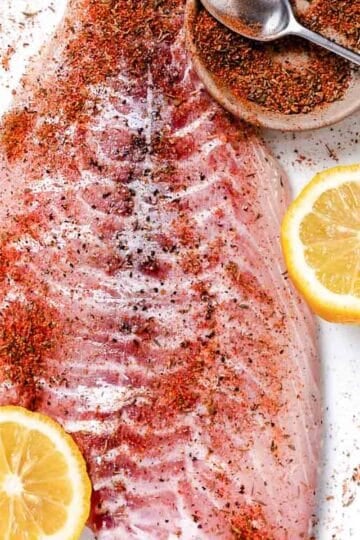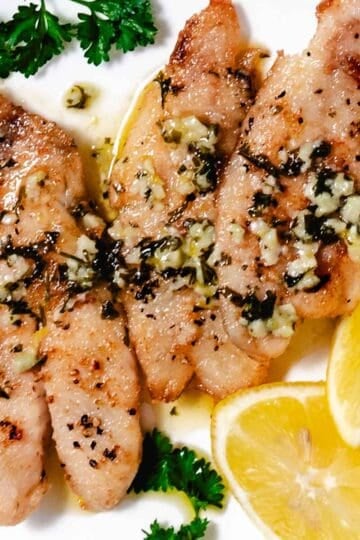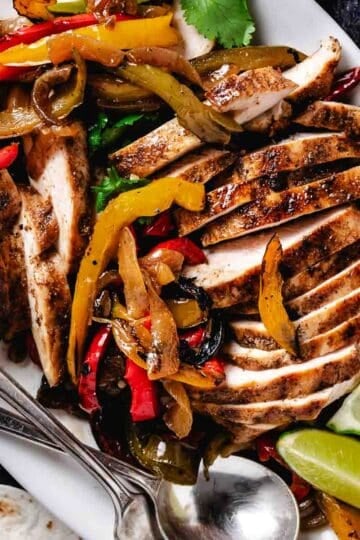Garnishing with parsley is a simple way to make your food look delicious. The green herb adds a pop of color, instantly making any dish more appealing. In this post, we will explore how to use a bunch of parsley. You’ll learn how to make the most of its flavor, color, and practical uses in your cooking.

Jump to:
Varieties of Parsley
The two common varieties of parsley are flat-leaf and curly parsley. They taste similar, but flat-leaf parsley has sturdier leaves and a stronger taste.
When shopping for parsley, always choose the freshest option. Look for firm green leaves without any wilting or yellowing.
- Italian flat-leaf parsley has broad leaves and a slightly peppery flavor that works well with many dishes, from gremolata to seared steak.
- French curly parsley, with its frilly, more dainty leaves, has a fresh flavor and adds texture to any plate. I like to use it on shrimp for a pop of color.

Parsley for Garnish
Start by washing your parsley without crushing the leaves.
Fill a bowl with cold water and swish it around to remove debris. Rinse under running water and lightly pat dry with a clean towel.
Trim away most of the long stems, leaving the leaves.
Chop the parsley into tiny bits or use sprigs with a bit of the stem.

How To Store Parsley
The best way to keep parsley fresh is to store it in the refrigerator. Trim the ends of the stems and place the parsley in a mason jar or glass with a few inches of water, like a bunch of flowers. Loosely cover the jar with a plastic bag, then refrigerate. Change the water every two days to keep it fresh.

Most of the time, I prefer wrapping parsley in a damp paper towel. When I bring it home, I wrap the bunch in a wet paper towel, place it back in the grocery store bag, and store it in the crisper drawer.
This keeps the parsley moist and fresh for about a week, sometimes longer, depending on its condition when I purchased it.
If you have extra parsley that you won’t use within a few days, freezing is the best way to preserve it. Wash and roughly chop the parsley while it’s still fresh.
Mince it and place it in ice cube trays, using a tablespoon for each cube. Once the cubes have frozen overnight, transfer them to a freezer bag. These cubes are perfect for stews, soups, sauces, and stir-fries.

How To Garnish with Parsley
Depending on the dish and occasion, you can use parsley in several ways. Here are some of my favorite dishes garnished with parsley.
Whole sprigs of parsley are a classic garnish. Place the sprig near the edge of the food to bring attention. Avoid covering too much food. Then, you can sprinkle some chopped bits of parsley over the food.
The garnish on this plate of Mahi Mahi with Cream Sauce includes a sprig of flat-leaf parsley, lemon zest, and freshly ground pepper.

Finely chopped parsley adds a layer of texture and color to your food.
- Sprinkle parsley over creamed soups like smooth potato or butternut squash to add texture and visual appeal. Add it to chicken soup for a touch of bright green.
- Use parsley to garnish mashed potatoes or rice dishes for a pop of color and break up the color.
- When serving a creamy mayo sauce on the side, pour it into a small bowl alongside your dish and sprinkle parsley on top. The green contrast breaks up the pale color, making it look better.
- With fish or meat, break up the colors with a pop of green.
Garnish For Seafood
- Sautéed Shrimp with Coconut Aminos: Bits of curly parsley and sesame seeds add color and texture to the shrimp.
- Seared Fish with Lemon Butter Sauce: Italian flat-leaf parsley is sprinkled on top of the buttery white fish for fresh flavor.
- Florida Blackened Swordfish: Green parsley breaks up all the red tones on this plate of fish.
- Stone Crabs with Mustard Sauce: the bright green parsley in two corners of this plate contrasts nicely with the red and pink colors of the stone crab claws.

Parsley Garnish For Soup
Parsley enhances the look and flavor of these soups, making them even more appetizing.
On the left image, Green Pea Soup is garnished with flat-leaf parsley and everything bagel seasoning. The garnish adds dimension to an otherwise flat bowl of soup.
On the left, this Instant Pot Chicken Soup is garnished with bits of curly parsley for a pop of contrasting color.

More Garnish Ideas
Parsley is a classic garnish that has been used for centuries. You can sprinkle it over vegetables, use it as a decoration, or mix it with lemon zest for extra flavor.
A good garnish blends seamlessly into the dish. It makes the plate look better without being the main focus, boosting the overall presentation.
While I often use parsley, if a dish features another herb, like dill, I’ll garnish with additional dill instead. It adds a similar burst of color and also connects the garnish to the dish’s flavors.
- Here are some garnishes you can use instead of parsley:
- Whipped cream
- Lemon zest
- Chopped nuts
- Edible flowers
- Parmesan cheese
- Shaved chocolate
- Pomegranate seeds
- Red chili flakes
Here are some examples of dishes garnished with herbs other than parsley.
- This Mango Passion Fruit Smoothie is topped with a slice of key lime and a piece of mango. It comes with a bright red pick and an old-fashioned red striped straw.
- These Fish Tacos and other Mexican foods use cilantro for both flavor and garnish. Choose fresh cilantro that is well-hydrated and lively. It the cilantro has wilted, place it in a bowl of cold water to bring it back.
- Sushi or Seared Tuna is garnished with sesame seeds and chopped green onions.
- Cold salads, like this Shrimp Salad with Mayo, is garnished with bits of dill. Not only does it add texture and color, but the dill garnish shows the herb used in the dish. This is a technique many restaurants use to make the food look better and help diners know what to expect.
- These brownies are a good example. The sprinkles are used as a garnish. They don’t change the flavor much, but they make the gooey treat look more appealing.


Takeaway
Garnishing with parsley can elevate your dishes, making them look and taste extra special. Whether you use curly parsley for texture or flat-leaf parsley for flavor, these simple tips will help you garnish like a pro.
To keep parsley fresh for a week, put it in a glass of water in the fridge. You can also wrap it in a damp paper towel. Keeping it hydrated is essential for extending its shelf life.
Parsley is the perfect finishing touch, adding a pop of color, texture, and flavor that ties a dish together.
A sprinkle of green can brighten a plain soup or add life to a plate of liver. It really changes the whole look.
Whether you use whole sprigs for decoration or finely chop it as an accent, parsley is a simple way to elevate any meal.
Adding a garnish like parsley shows attention to detail in your cooking. Experiment with different dishes and see how this herb can make your food shine!
FAQ
When choosing a garnish, pick something that fits with the flavors of your dish. For example, lemon slices are great with seafood, and a sprinkle of Parmesan works well with pasta or veggies. Keep it simple by using an ingredient already in the dish, like fresh herbs or a few extra vegetables. This helps the garnish enhance the flavors without taking attention away from the main dish.
A garnish is a small addition to a dish. It is often made from herbs, fruits, or vegetables. Garnishes make the dish look better and taste better, too. It's the finishing touch that makes food look and taste even better!
Absolutely! Other herbs like cilantro, dill, or chives work well. You can also use ingredients like lemon zest, grated cheese, or even edible flowers, depending on the dish.
To garnish meat with parsley, you can chop it up and sprinkle it over the top of the meat to add a bright green color and fresh flavor. Another option is to place a whole parsley sprig on the side of the plate to make it look more put-together.






Leave a Reply
You must be logged in to post a comment.